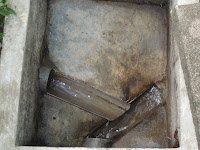Hereby, i shall bring you to the final week of our DHO posting in Baling, Kedah.
 SUNDAY 9TH DECEMBER 2007
SUNDAY 9TH DECEMBER 2007- The topic for the day was primary care. PPKP Danial met the team in Klinik Kesihatan Kupang. We were briefed regarding the various primary care services available. Among the services available include Diabetic clinic, Antismoking clinic, Geriatric clinic, Hypertension clinic, HIV screening clinic and many more.
- PPKP Danial also briefed us regarding the emergency set up and basic life support. We were also taught regarding the functions of each item on the emergency trolley. We were also briefed about how an emergency call is directed to the call centre in Hospital Sultanah Bahiyah, Alor Star from Telekom Malaysia.
- Later in the evening, we attended the antismoking clinic in hospital Baling. Encik Mohd Rusli briefed us on how the clinic is run according to protocols set up by the Health Ministry. Later, we observed him counseling a new patient.
MONDAY 10TH DECEMBER 2007
- We met PPKP Nizam who is in-charge of Kawalan Mutu Makanan. We were briefed regarding the various forms available, the procedure of collecting food samples and transporting it to Butterworth, and also procedures regarding the closure of food premises.
- Later, PPKP Mazran explained to us about KPAS, that is the abbreviation of Kesihatan Pekerja dan Alam Sekitar. He explained to us regarding the duties and programmes of KPAS.
Among the activities carried out are:
(a) surveillance of cases of injuries and skin diseases among factory workers
(b) investigation and management of needle stick injuries
(c) education of workers regarding safety equipments
(d) monitoring of the school environment
(e) monitoring the cleanliness and sanitation of the Pusat Latihan Khidmat Negara before and during the programme
(f) supporting ‘healthy setting’
(g) early detection of cardiovascular diseases among workers
(h) investigation of public complains such as complains of cleanliness of animal farms
 TUESDAY 11TH DECEMBER 2007
TUESDAY 11TH DECEMBER 2007- The Department of Food Quality Control arranged to take us to observe the process of food sampling. We first gathered at Pejabat Kesihatan Baling at 8 am and then left for Petronas with the Food Quality Control team at 9am. Upon arrival, we observed the team collect 5 samples of food from the Petronas Mesra convenient store. The 5 samples collected were Dutch Lady Full Cream milk, Tiger brand milk cookies, Silverbird fruit cake, DRINHO soya bean and OOZI peanut butter. We then learned the methods of packaging the food items, labeling them and sealing it with the seal labeled ‘ LAK Rasmi”.
- Then, we followed the team to Butterworth where we observed how the items were received and registered for microbiology investigation by Makmal Keselamatan dan Kualiti Makanan, Negeri Pulau Pinang.

 WEDNESDAY 12TH DECEMBER 2007
WEDNESDAY 12TH DECEMBER 2007- We attended the Blindness Detection Programme or rather known as ‘Program Kebutaan’ in Klinik Kesihatan Tawar. This is an activity arranged under Non-communicable Diseases Control (NCDC) unit.
- We were briefed by Penolong Pegawai Perubatan Encik Amir regarding this programme. This Blindness Detection Programme is the pioneer programme in the country. Its center is based in Klinik Kesihatan Tawar. Therefore, all referrals from any health centers in the district of Baling would be sent here for evaluation before being referred to Sungai Petani for consultation by the opthalmologist.
- According to statistics, Perak is the state affected with the highest amount of blindness. Kedah currently ranks as the state with the sixth highest amount of blind cases in the country.
In 1950, it was recorded that 38 million people in the world were affected by blindness according to statistics prepared by WHO. Later on, a study was carried out in Malaysia from year 1996 to 1998. It was discovered that 2.71% (518680 people) out of 19 million people were affected with blindness.
- We learnt on how the screening process for blindness was done, the various methods of investigations and the different types of treatment provided.
- The Blindness Detection Programme unit is very active as they not only provide this service every Thursdays in Klinik Kesihatan Tawar, but also participate continuously in many of the health campaigns arranged by the district health office with the hope of creating awareness in the community pertaining the importance of healthy vision.





This is a photo of some of us bidding 'goodbye' to some of the stuffs in the Pejabat Kesihatan Daerah Baling.










































